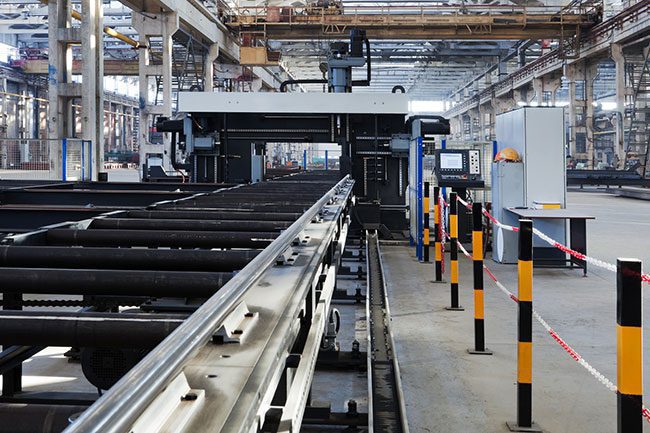How Overhead and Floor Conveyors Maximize Space

As a manager in the automotive industry, you have to face many challenges in meeting your production targets. Conveyor systems play an important role in increasing productivity, ensuring good workflow and maximizing your floor space usage.
Moving large or heavy components between workstations cannot always be achieved using manual labor, making conveyor systems the ideal solution for these tasks. They help to maximize work efficiency and play an important role in automated production systems.
In this article, we’ll be looking at the various conveyor systems available and what benefits they provide.
What is a conveyor system?
This is an automated transportation system used mainly in factories and warehouses.
It can be a flat belt conveyor that moves goods in a standing position or a hanging system – where goods hang from points.
A hanging conveyor can be over head or on the floor. This system uses chains that drive the hanging points along a rail. It can move around corners and lift goods vertically.
Overhead Conveyors
These systems have the obvious advantage of floor space maximization, by allowing components and complete vehicles to be moved safely above normal working height.
They also allow for workstations to be stacked above one another, making full use of your available space. In addition to this, it can speed up production time by moving components over a shorter distance.
Here are the types of overhead conveyors that one would typically use on an automotive production line.
- Closed Track Power and Free Conveyors
These are known as closed track conveyor systems because the chain and drive wheels are enclosed in the steel track. The primary advantage of this type of system is that it can be used in an inverted position. This means that components can be moved in a hanging position and the track can loop 180 degrees – the component then will be in a standing position. This allows for both overhead and floor use, which is ideal where floor space is limited.
A closed track is also recommended for use in spray booths because the moving parts are protected from overspray. Paint that dries on moving parts in an open track system, will later chip off and fall onto the surface being sprayed – damaging the paintwork.
The power and free system gives one versatility by allowing a hanging loop to be released from the moving chain. This means that an individual item can be stopped, while the others continue to move along the track.
- Open Track Monorail or I-beam conveyor systems
This system differs from the previous type, in that the chain and drive wheels are exposed, moving along a single I-beam track. It doesn’t allow for inverted or power and free operation but it is more cost effective. This can make a big difference when moving heavier items like complete vehicles.
- Twin Trolley System
This can use either an open or closed track system. Here the system runs on two synchronized tracks. This gives one greater flexibility for upgrades without requiring additional installation. It also gives one the ability to move the conveyor system at higher speeds.
- Vertical Adjusting Conveyor
This can be used with single or monorail systems. It allows for height adjustment, eliminating the need for movable work platforms that require workers to climb to different levels – saving on floor space and time.
Floor Conveyor Systems
Floor conveyor systems will greatly reduce working time and save floor space. If one considers the amount of space needed to move a vehicle using a forklift, you have to take into account the large area needed to maneuver the forklift and the safety zones required when using a moving vehicle on a factory floor.
Floor conveyors also provide for moving work stations, saving time and space.
- Belt Conveyor System
This makes use of a single belt traveling in a continuous loop. It provides excellent stability allowing for precision work to be conducted on a component whilst in motion.
- Slat Conveyor System
This system uses two chain or belt driven rails with slats placed across them. This provides for increased versatility and chain driven slats can move through heated areas like paint baking ovens and wet areas like dipping troughs.
- Skillet System
A skillet on a belt conveyor means that one can create a moving working station, where both the vehicle and the technician can move on a belt conveyor. The skillet can also be height adjusted to perform tasks on different areas of the vehicle.
A conveyor system is custom-designed for each factory, enabling you to maximize your available floor space and ensure a smooth and efficient production line.
To find out more about conveyor systems, contact Swanton Welding to get the best expertise and service to meet your needs.

